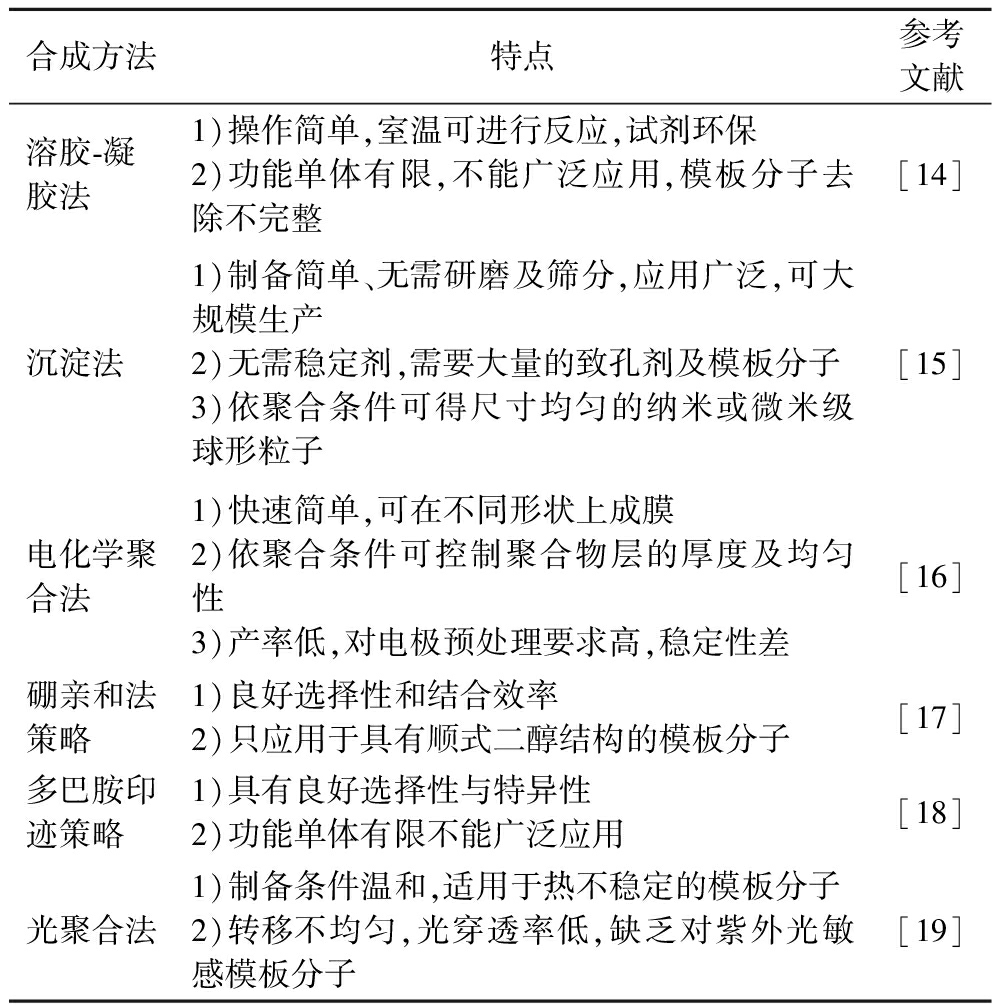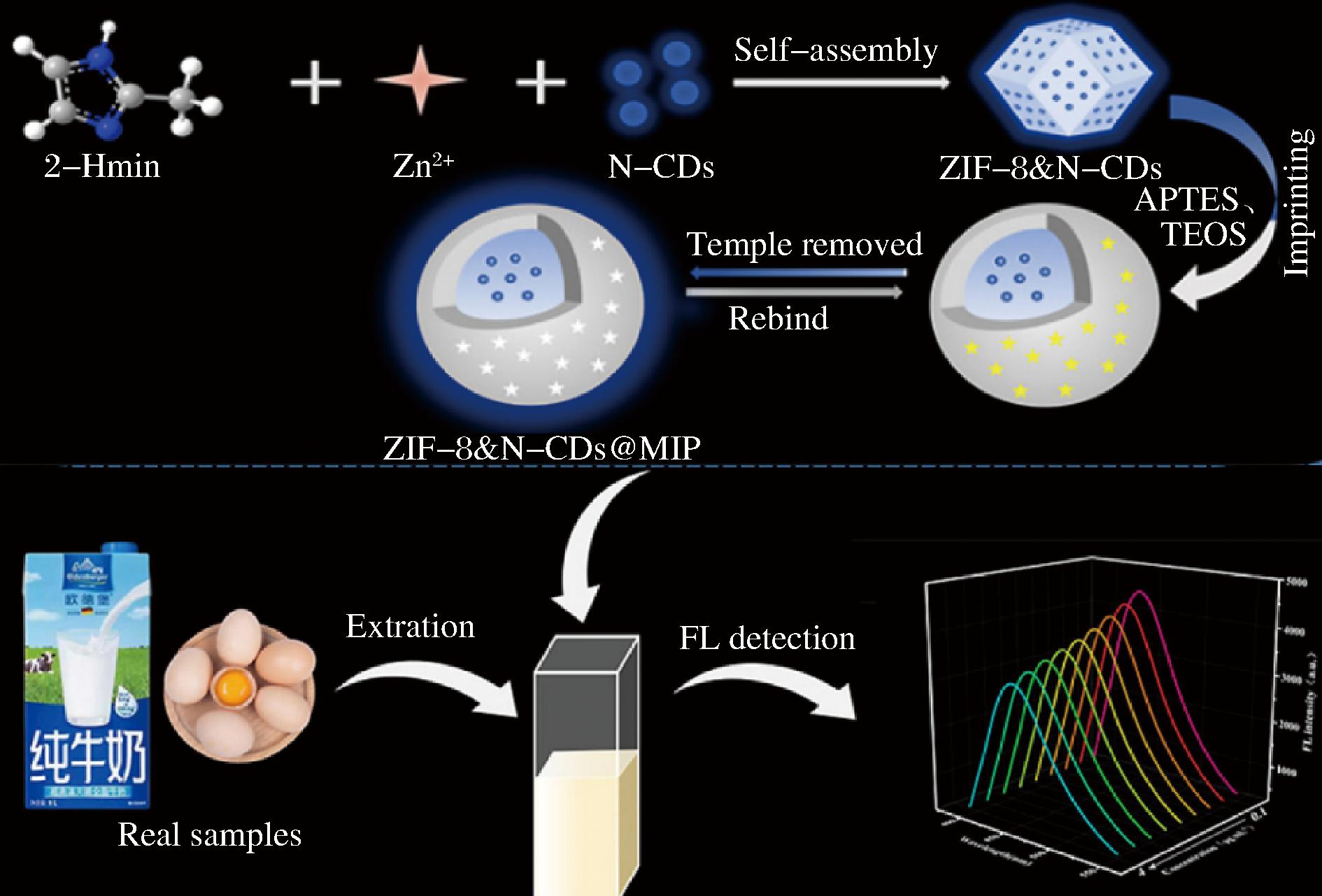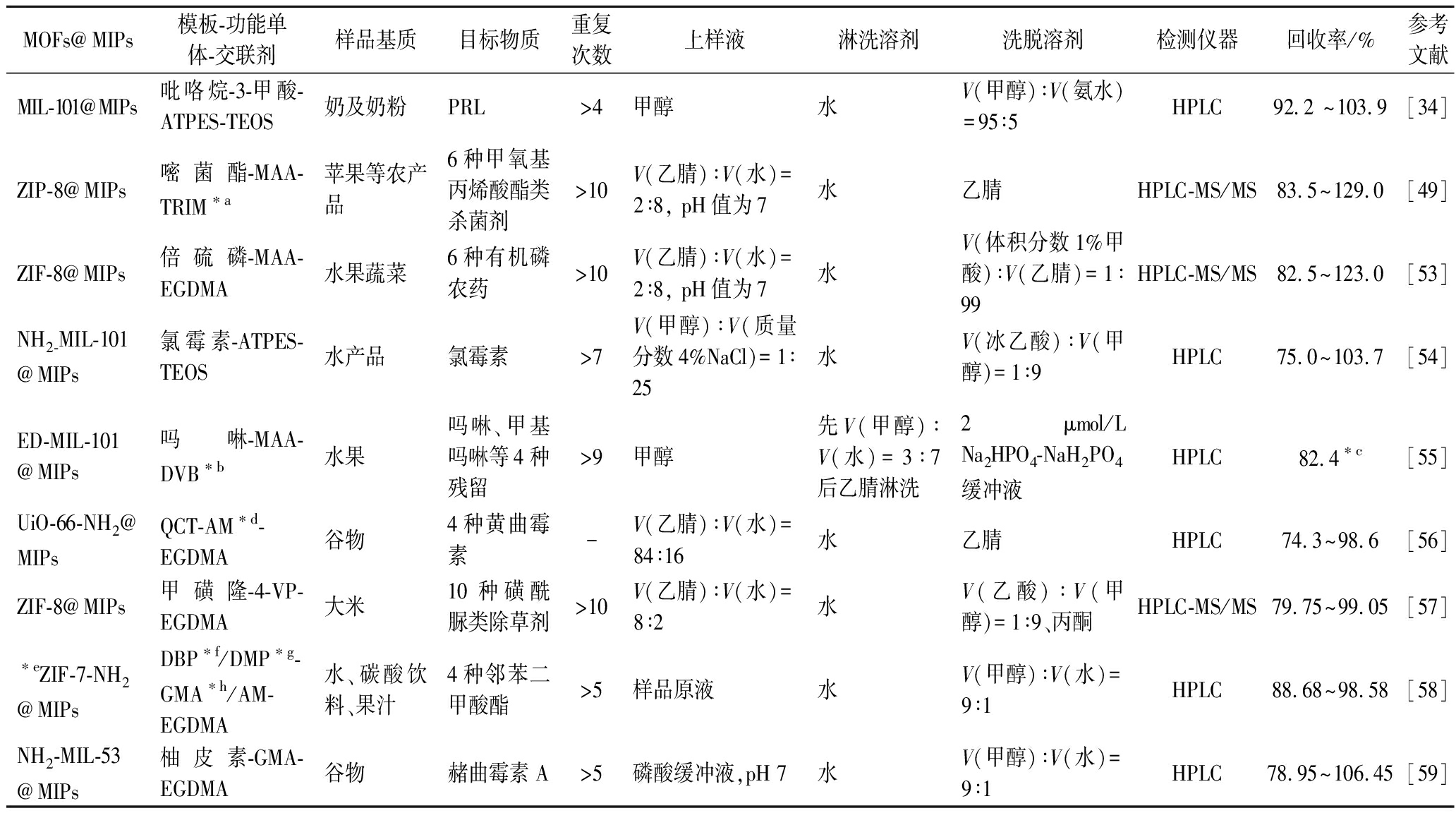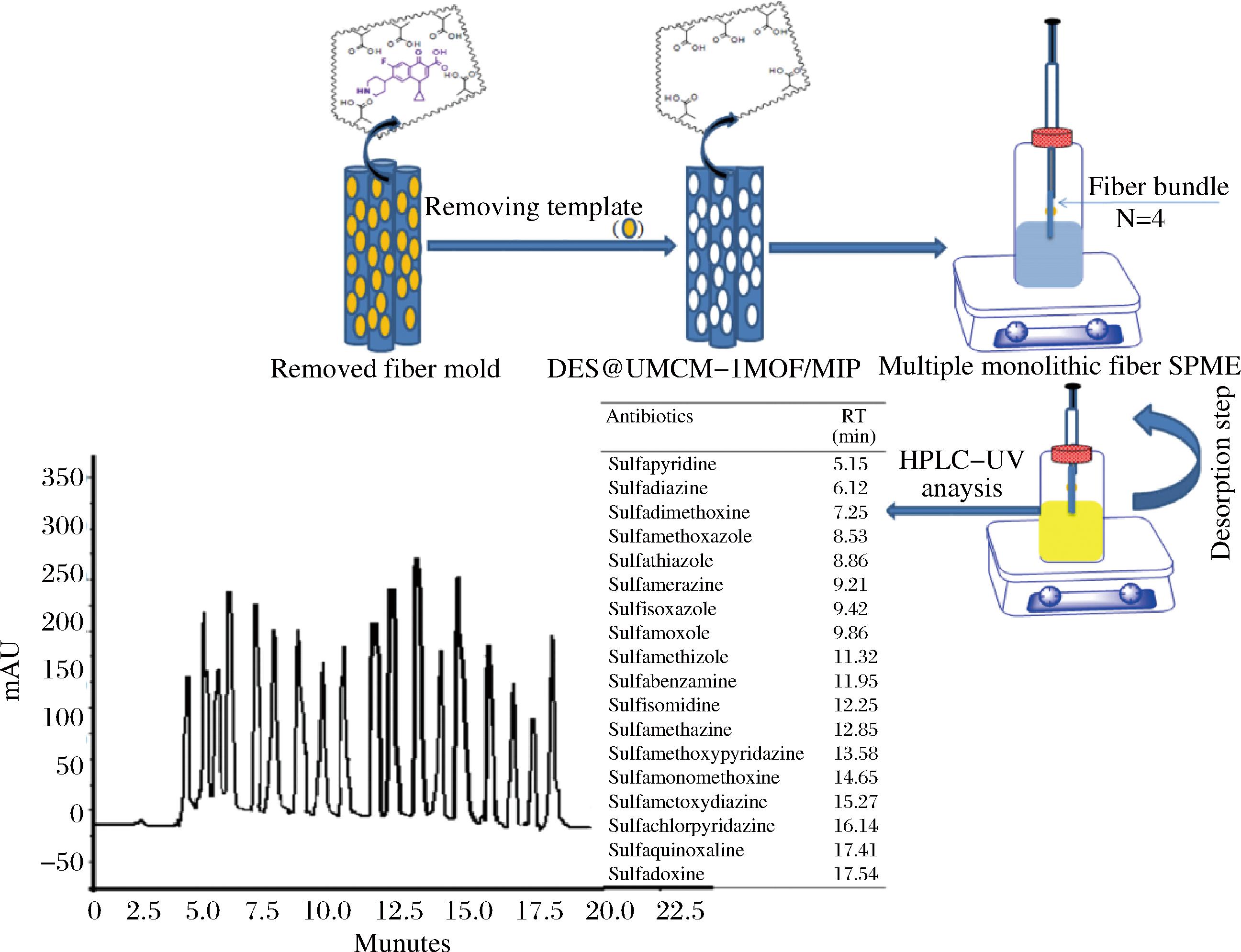食品安全是重大民生问题,食品检测则是保障食品安全的重要环节。开发新型材料用于构建小型化、高灵敏的食品检测传感器,有利于实现目标物质的现场即时检测,有效阻断危害蔓延[1];探究选择性好,抗干扰能力强的新型样品前处理材料,发展准确度好、精密度高的仪器分析技术有利于多种目标物质的高通量准确监测及识别[2],对于保障食品安全和人类健康意义重大。
金属有机骨架材料(metal organic frameworks,MOFs)是由无机金属离子作节点,有机配体作连接桥,通过配位作用组装而成的新型无机-有机杂化结晶三维多孔材料,具有超大比表面积及发达的孔隙结构,按照系列不同,主要分为四大系列(见表1)。MOFs 具有结构多样性和可设计性,可通过改变MOFs金属离子、有机配体、结合其他纳米材料[3-4]等派生出结构多样、性能优异的MOFs衍生材料,在气体的吸附[5]、药物递送[6]、催化[7]及样品前处理[8]等领域应用较多。分子印迹聚合物(molecularly imprinted polymers,MIPs)的制备如图1所示,以目标分子为模板,在功能单体、交联剂、引发剂、致孔剂的作用下,交叉偶联聚合形成单体-模板分子印迹聚合物,模板分子嵌入在聚合物交联网络中,随后被洗脱掉,形成具有三维空腔的高分子记忆材料即为MIPs。由于空腔在尺寸、形状、化学功能上与目标分子互补,因此MIPs对目标分子具有较好的亲和性、优异的选择识别能力,已被广泛应用于样品前处理[9]、色谱分离[10]、传感[11]等领域。

图1 MIPs制备原理示意图
Fig.1 Schematic diagram of MIPs preparation principle
表1 MOFs的主要系列
Table 1 The main series of MOFs

系列金属离子有机配体主要代表典型代表结构示意图网状金属有机骨架(isoreticular metal-or-ganic frameworks, IRMOFs)Zn2+等芳香羧酸IRMOF-1、IRMOF-5等(IRMOF-1)类沸石咪唑骨架(zeolitic imidazolate frameworks, ZIFs)Zn2+、Co2+等咪唑或其衍生物等ZIF-8、ZIF-7等(ZIF-8)
表1

系列金属离子有机配体主要代表典型代表结构示意图莱瓦希尔骨架(material sofistitute la-voisier frameworks, MILs)Fe3+、Al3+、Cr3+等脂肪族羧酸MIL-101、MIL-53等(MIL-101)锆基金属有机骨架(University of Oslos, UiOs)Zr4+等1, 4-苯二甲酸等UiO-66等(UiO-66)铜 基 金 属 有 机 框 架(Hong Kong Unicersity of Science and Technology, HKUST)铜基金属等1,3,5-苯三甲酸等HKUST-1等HKUST-1
基于金属有机骨架的分子印迹聚合物(metal organic framework-based molecularly imprinted polymers,MOFs@MIPs)是以MOFs为核,MIPs为壳复合而成的新型材料。MIPs的柔性骨架在一般的碳-碳单键中容易变形和团聚,致使其吸附能力、选择性及稳定性降低[12],而MOFs刚性骨架的引入则可有效地防止MIPs印迹空腔的变形,且可提供更多的孔隙数量,识别位点,吸附容量更高、识别速率更快。此外,MIPs包覆在MOFs表面,形成具有优异化学和机械稳定性以及出色识别能力的空腔层,使MOFs@MIPs材料具有更高的黏附性,更好的选择性,骨架更加稳定[13]。目前越来越多的研究致力于将 MOFs和MIPs结合起来,通过两者协同作用发挥它们的最大效能,合成具有特异性识别的高性能靶向复合材料MOFs@MIPs(表2),并将其应用于构建高性能食品检测传感器[20]及样品前处理[21]等领域,逐渐成为食品检测研究的热点材料之一,具有良好的应用价值和可推广性。
表2 MOFs@MIPs的合成方法
Table 2 Synthesis strategies of MOFs@MIPs

合成方法特点参考文献溶胶-凝胶法1)操作简单,室温可进行反应,试剂环保2)功能单体有限,不能广泛应用,模板分子去除不完整[14]沉淀法1)制备简单、无需研磨及筛分,应用广泛,可大规模生产2)无需稳定剂,需要大量的致孔剂及模板分子3)依聚合条件可得尺寸均匀的纳米或微米级球形粒子[15]电化学聚合法1)快速简单,可在不同形状上成膜2)依聚合条件可控制聚合物层的厚度及均匀性3)产率低,对电极预处理要求高,稳定性差[16]硼亲和法策略1)良好选择性和结合效率2)只应用于具有顺式二醇结构的模板分子[17]多巴胺印迹策略1)具有良好选择性与特异性2)功能单体有限不能广泛应用[18]光聚合法1)制备条件温和,适用于热不稳定的模板分子2)转移不均匀,光穿透率低,缺乏对紫外光敏感模板分子[19]
目前,已有MOFs@MIPs复合材料的相关综述,主要集中于合成方法,构建传感器策略[22-23]及MOFs@MIPs基传感器在环境监测、药物分析等方面的应用研究[24]。以食品检测为视角,针对该新型材料在食品检测领域应用研究的系统性综述仍较匮乏。基于此,本文综述了近5年来,MOFs@MIPs作为构建传感器及前处理材料在食品检测中的应用,为其在该领域更为深入广泛的应用研究提供参考。
1 基于MOFs@MIPs构建的传感器在食品检测中的应用
MOFs缺乏信号传导及特异性选择能力,但其大比表面积及孔隙率,利于接触和富集底物,提高电极的灵敏度,功能化后的MOFs可提高传导能力,缩短检测时间,是电极表面改性的理想材料。MIPs缺乏导电性和电催化活性,只能识别待测物,不能输出信号,但MIPs具有良好的环境耐受性、高选择性,是敏感识别元件研究的重要材料,将其用于制备探针可增加特异性和灵敏度[25]。开发功能化的MOFs@MIPs复合材料并将其应用于构建简单高效、成本低廉、高稳定性的食品检测传感器,尤其是电化学、荧光传感器,具有良好的应用价值和可推广性。
1.1 电化学传感器
电化学传感器是基于目标物的电化学性质进行分析检测的,电极的修饰是构建性能优异电化学传感器的关键。BEIGMORADI等[26]将制备的HKUST-1@MIPs对石墨环氧树脂(graphite-epoxy,GE)电极进行了修饰,制备了HKUST-1@MIPs-GE电极并应用于水果中多菌灵(carbendazim, CBZ)的检测(见图2)。在0.01~50.00 μmol/L范围内线性关系良好,重现性好,检出限为2 nmol/L。AN等[27]采用溶剂热法制备了含有丰富Fe2+/Fe3+氧化还原电子对的MIL-53(Fe),将其涂于裸玻碳电极(glassy carbon electrode, GCE)表面对其改性,并在GCE表面聚合MIPs,构建MIPs-MIL-53(Fe)/GCE。Fe2+/Fe3+的氧化还原电位与[Fe(CN)6]3-/4- 峰值电流电位的协同作用,使得MIL-53(Fe)可充当电子媒介,能有效提高电子传递速率,放大电化学信号,采用[Fe(CN)6]3-/4- 为氧化还原探针与MIPs联合,分析物与MIPs识别位点的特异性结合降低了氧化还原标记物的渗透性,间接检测牛奶样品中的三聚氰胺含量,检测范围为0.01 nmol/L~1.00 μmol/L,检出限低至 8.21×10-3nmol/L,回收率在93.4%~103.5%。

图2 HKUST-1@MIPs的合成及在检测水果中CBZ的应用[27]
Fig.2 The synthesis of HKUST-1@MIPs and its application in detecting CBZ in fruits[27]
研究中,将MOFs与金属及金属氧化物、石墨相氮化碳(graphite carbon nitride,g-C3N4)等常用于电化学传感器的材料结合,再与MIPs复合,既可加速电子转移,克服MOFs导电性差、电活性弱等缺点,又可有效提高电极的表面吸附性能、印迹位点数及电催化能力[28],实现食品复杂基质中目标物的高灵敏和特异性实时检测。XU等[29]将具有Pt纳米颗粒(platinum nanoparticles,PtNPs)活性位点的Pt-UiO-66掺入自制的碳糊微电极(carbon paste microelectrode,CPME)中,然后将介孔分子印迹聚合物(mesoporous MIPs,mMIPs)合成到pt-UiO-66/CPME上,制备了用于农产品中有机磷杀虫剂伏杀硫磷(phosalone,PAS)的高灵敏度和选择性检测的电化学传感器。pt-UiO-66显著放大了伏安法测定的信号,纳米级MIPs为PAS检测提供了优异的性能,增强了电子传输能力、提高了扩散能力和识别特异性,所得电极在0.50 nmol/L~20 μmol/L范围内表现出了良好的线性,检出限可低至0.078 nmol/L,对PAS的分析测定具有良好的重复性、重现性和稳定性。MEHMANDOUST等[30]将制备的MIP-Au@MOF-235@g-C3N4纳米材料涂于GCE上用于检测蔬菜中的杀虫剂苯线磷,复合材料具有较大的比表面积及高催化活性,使制备的传感器具有良好的电化学性质,在0.01~16.4 μmol/L范围内线性关系良好,回收率为94.7%~107.9%,RSD值<1.0%。
1.2 荧光传感器
近年来,将发光金属骨架(luminescent metal organic frameworks,LMOFs)和MIPs复合,构建抗干扰能力强、灵敏度高的新型荧光传感器,并将其应用于食品安全检测的研究逐渐增多,如表3所示。LMOFs的发光性能常可通过2种方式实现:一是合成可产生荧光发射的MOFs;二是将具有优异发光性能的纳米颗粒如金纳米团簇、量子点(quantum dots,QDs)、碳点(carbon dots,CDs)、氮掺杂碳点(nitrogen-doped carbon dots, N-CDs)等嵌入MOFs骨架内制备出具有发光特性的MOFs@MIPs。
表3 基于MOFs@MIPs构建的荧光传感器在食品安全检测中的应用
Table 3 Application of fluorescent sensors in food safety detection constructed by MOFs@MIPs

传感器目标物质模板分子-功能单体-交联剂检测限线性范围样品参考文献NH2-UiO-66@MIPs褪黑素褪黑素-MAA∗a-EGDMA∗b0.18 ng/mL1~100 ng/mL果汁[31]NH2-UiO-66@MIPs4-硝基苯酚4-硝基苯酚-MAA-EGDMA0.009 μmol/L0.05~50 μmol/L饮用水[32]NH2-MIL-53@MIPs玉米赤霉烯酮2,4-二羟基苯甲酸环十二烷酯-ATPES∗c-TEOS∗d0.018 mg/L0.05~1.0 mg/L小麦[33]AgNPs∗e@ZnMOFs@MIPs棒曲霉素(patulin, Pat)Pat-ATPES-TEOS0.06 μmol/L0.1~10 μmol/L水和苹果汁[34]NH2-MIL-53@N,P-CDs@MIPs金霉素(chlortetracycline,CTC)CTC-ATPES-TEOS0.019 μg/mL0.06~30 μg/mL牛奶[35]NH2-UiO-66@MIPs氯霉素(chloramphenicol,CAP)CAP-MAA-EGDAMA0.013 μg/L0.16~161.56 μg/L牛奶、蜂蜜[36]NH2-UiO-66@g-CdTe∗f@r-CdTe∗g@MIPsCAPCAP-ATPES-TEOS3.8 μg/g0.01~0.5 μg/kg;0.5~4.5 μg/kg动物源性食品[37]N,S-GQDs@ZIF-8@MIPs章鱼胺(octopamine, OA)OA-ATPES-TEOS0.062 mg/L0.1~10 mg/L发酵食品[38]
注:*a:甲基丙烯酸(methacrylic acid,MAA);*b:乙二醇二甲基丙烯酸酯(ethylene dimethacrylate, EGDMA);*c:3-氨丙基三乙氧基硅烷[(3-aminopropyl)triethoxysilane,APTES];*d:正四乙基正硅酸盐(tetraethyl orthosilicate,TEOS);*e:银纳米颗粒(silver nanoparticles,AgNPs);*f:绿色碲化镉(green CdTe,g-CdTe);*g:近红外碲化镉(near infrared red,r-CdTe)。
1.2.1 LMOFs@MIPs基荧光传感器
LMOFs的发光性能可通过改变金属(如镧系金属)、有机配体(带有发光形式的官能团),合成可产生荧光发射性能的MOFs的形式实现。镧系MOFs(lanthanide MOFs,LnMOFs)因镧系金属离子的4f电子壳层具有独特的能级分布和能量跃迁特性,使LnMOFs受激发后能够发射特定的发光信号[39]。
ESKANDARI等[40]在发光棒状Tb(III)MOF-76上印迹mMIPs,合成了具有稳定传感性能、高灵敏度和选择性的复合材料mMIPs@MOF-76,去除模板分子后,复合材料具有与Tb发射光谱对应的强烈荧光发射,如图3-a所示,MIPs选择性地吸附毒死蜱(chlorpyrifos,CP)分子并将其定位在MOFs表面附近,CP对mMIPs@MOF-76的荧光发射具有显著猝灭效应。在10~1000 ng/mL范围内,CP浓度与荧光强度(λex 285 nm和λem 544 nm)线性关系良好,检测限为3.41 ng/mL。可用于果汁中CP的测定。ZHANG等[18]以对苯二甲酸(terephthalic acid,PTA)为配体,合成不需要额外发光底物的MIL-53(Fe),通过自聚合方法将聚多巴胺(polydopamine,PDA)覆盖在MIL-53(Fe)表面,合成具有优良仿过氧化物酶活性及甲硝唑(metronidazole,MNZ)特异性识别的MIL-53(Fe)@MIPs复合物,构建了检测MNZ的荧光传感器,如图3-b所示。MIL-53(Fe)框架中的Fe(III)具有优异的催化性能,可以催化H2O2氧化生成羟基自由基(·OH),PTA能够捕获·OH,形成可发射蓝色荧光的羟基对苯二甲酸(hydroxyterephthalic acid,PTA-OH)。若MIL-53(Fe)@MIPs上的模板分子未被洗脱,空腔被模板分子阻断,阻碍了H2O2进入MIL-53(Fe)@MIPs,PTA就不能被氧化产生荧光。当MIL-53(Fe)@MIPs上的模板分子被完全洗脱时,MIL-53(Fe)@MIPs表面暴露了许多空腔,H2O2能顺利进入空腔,并与PTA反应,导致MIL-53(Fe)@MIPs的氧化,在315 nm激发波长下,在460 nm波长处有一个明显的发射峰。这些空腔具有记忆功能,目标分子MNZ可以重复阻断它们,从而产生MNZ检测器。优化条件下,该传感器在1~200 μmol/L范围内线性关系良好,检测限为53.4 nmol/L。牛奶和人血清基质中的加标回收率为93.2%~102%,RSD<3%。WANG 等[41]开发了“turn-off”传感类型的NH2-UiO-66(Zr)@MIPs荧光传感器,并首次用于牛奶中土霉素(oxytetracycline, OTC)的超灵敏检测。如图3-c所示,Zr4+和2-氨基对苯二甲酸(2-aminoterephthalic acid,ATA)通过自组装策略制备了具有强烈蓝色荧光发射的NH2-UiO-66(Zr)。随后,采用一步聚合法制备了一种基于MIPs包覆的NH2-UiO-66(Zr)的新型仿生荧光传感器。NH2-UiO-66(Zr)作为发光中心和载体,提供了优异的荧光信号输出和响应灵敏度。MIPs的修饰使传感器对OTC具有高选择性、吸附亲和力和结合效率。所制备的传感器在OTC浓度为0.05~40 ug/mL范围内显示荧光线性猝灭,检出限为0.012 μg/mL,具有良好的荧光稳定性、精密度高和重现性好。

a-Tb(III)MOF-76@mMIPs的合成及检测原理示意图[40];b-MIL-53(Fe)@MIPs的合成及检测原理示意图[18];c-NH2-UiO-66(Zr)@MIPs的合成及在检测牛奶中OTC的应用[41]
图3 LMOFs@MIPs 构建的荧光传感器器在食品检测中的应用
Fig.3 Application of fluorescent sensors in food safety detection constructed by MOFs@MIPs
1.2.2 嵌入发光纳米颗粒构建荧光传感器
具有优异荧光性能的纳米颗粒,如CDs、N-CDs、QDs等可作为MOFs@MIPs的荧光团用于构建荧光传感器。CDs@MOFs@MIPs复合材料,将具有优异荧光性能、易于表面功能化的CDs分散在MOFs内,可有效防止CDs聚集产生的荧光淬灭效应,CDs与目标物质之间发生氧化还原反应、螯合反应、共价键结合作用、静电相互作用或能量转移等,从而实现对待测物的定性或定量分析[42]。XU等[43]采用一锅法构建了CDs嵌入MOFs载体的分子印迹荧光传感器。
首次采用室温反应制备载体ZIF-8,将CDs嵌入ZIF-8。采用本体聚合法制备MIPs,再经表面分子印迹技术制得CDs@MOFs@MIPs复合材料,以MOFs为基体,嵌入的蓝色发光CDs作信号传感器,感测传感器和目标分子间的键合相互作用并转换为可检测的荧光信号,MIPs提供目标物质吸附和识别位点,用于检测保健食品中银杏叶提取物中痕量的槲皮素(Quercetin,QCT)。CDs@MOFs@MIPs结合了CDs、MOFs、ZIF-8的优点,与CDs@MOFs@NIPs相比,对目标分子具有更高的选择性与敏感性;与CDs@MIPs相比,具有更优异的荧光强度,更快的反应速率,更短的吸附平衡时间。所构建传感器的荧光强度随QCT浓度从0~50 μmol/L间呈良好的线性下降,检测限为2.9 nmol/L,可用于检测痕量QCT,重复性好,精密度为1.9%,且与高效液相色谱法(High performance liquid chromatography,HPLC)检测结果吻合,适用于现场快速检测。ZHANG等[44]将氮掺杂碳点(nitrogen-doped carbon dots, N-CDs)嵌入ZIF-8中,通过溶胶-凝胶法制备了N-CDs@ZIF-8@MIPs,开发了用于鸡蛋、牛奶中四环素(tetracycline, TC)的高选择性、高灵敏度的新型荧光传感器,合成检测方法如图4所示,N-CDs@ZIF-8@MIPs综合ZIF-8、N-CDs、MIPs优点,用具有大比表面积多孔的ZIF-8包埋具有优异荧光性能的N-CDs,既增强了TC的高效积累,又避免了荧光聚集引起的N-CDs猝灭,MIPs的复合则解决了对TC缺乏特异选择性的不足。在优化条件下,检测器的检出限可达0.045 μg/mL,回收率可达80.67%~95.22%。

图4 ZIF-8&N-CDs@MIP的合成及在检测纯牛奶和鸡蛋中TC的应用[44]
Fig.4 Synthesis of ZIF-8&N-CDs@MIP and its application in detecting TC in pure milk and eggs[44]
QDs如CdSe、CdTe、CdS等,量子产率高、稳定性好、发光光谱窄,可与分析物的电荷或能量转移相互作用而受到越来越多的关注[45]。LIU等[46]将具有高选择性的MIPs、强荧光的QDs、高比表面积的MIL-101复合,制备了荧光传感器。以具有高荧光量子产率的CdSe/ZnS QDs纳米晶为荧光元件,QDs感知MIPs与目标分子间键的相互作用,并将其转化为荧光信号,当目标物质吡咯啉(pyrraline, PRL)与MIPs@MOFs&QDs结合时,电荷由QDs转移到PRL,导致QDs的荧光强度淬灭,通过荧光猝灭检测奶粉中的PRL。MIPs保证了高选择性,QDs和MOFs双信号放大保证了灵敏度。优化条件下,在5×10-6~1×10-3mol/L范围内,荧光强度与PRL浓度成线性关系,检出限可达3.9×10-6mol/L,回收率可达90%~110%。
2 MOFs@MIPs在食品检测前处理中的应用
食品样品种类繁多,成分复杂,对其中痕量、超痕量目标物质的分析,尤其依赖于样品前处理技术。近年来,固相萃取、磁性固相萃取、基质固相分散萃取、固相微萃取等前处理技术因试剂耗量少、高效快速等优点广泛应用于食品检测中。吸附材料是前处理技术的关键,发展选择性高、富集能力强的新型吸附材料成为样品前处理技术的研究热点[47]。MOFs@MIPs复合材料既可有效克服MOFs材料结构稳定性差、选择性差的缺点,又可克服MIPs容量低、印迹位点可及性差、传质速率慢、模板易泄露等问题,将MIPs的高选择吸附能力与MOFs的高吸附容量有机结合,可显著提高对目标物质的选择性、传质速率、吸附效能、灵敏度且可重复多次使用,在检测食品样品中添加剂[48]、药残[49]、兽残[50]、真菌毒素[51]、营养功能性成分[52]等的提取与预浓缩前处理中具有良好的应用前景。
2.1 固相萃取(solid phase extraction,SPE)
SPE技术,以其试剂耗量少,可批量处理样品,既可去除杂质又可富集目标物的优势,成为食品安全分析检测中广泛使用的前处理净化技术,主要分为活化、上样、淋洗、洗脱等步骤。SPE柱中的填料是分离净化成功的关键,目前SPE填料仍存在吸附量小、易受复杂基质干扰、富集效率低、缺乏特异性吸附、重复利用性差等不足。MOFs@MIPs复合材料具有特异性识别能力,吸附容量大,且可多次重复利用,可有效解决传统SPE柱存在的一些问题。LI等[53]采用表面分子印迹技术制备ZIF-8@MIPs材料,并将其用做SPE柱的吸附材料,与高效液相色谱串联质谱(high performance liquid chromatography tandem mass spectrometry,HPLC-MS/MS)检测果蔬中的5种有机磷农药(organophosphorus pesticides,OPPs)。ZIF-8的引入提高了复合材料的传质速率,与单一MIPs 吸附 OPPs 所用的饱和吸附时间(180 min),吸附剂用量(500 mg)相比,ZIF- 8@MIPs的饱和吸附时间(10 min)明显缩短,吸附剂用量(20 mg)更少。在优化条件下,ZIF-8@MIPs对OPPs具有良好的特异性识别能力;重复使用10次后,OPPs回收率仍可>84.63%,具有良好的重复使用性能;方法在农产品(花椰菜、萝卜、梨、甜瓜)中的回收率为82.5%~123.0%,RSD<8.24%。于亭亭等[54]以MIL-101为载体,以氯霉素(chloramphenicol,CAP)为模板分子,通过溶胶凝胶法制备了具有良好CAP特异吸附性能,去杂质能力强的核壳型 CAP 分子印迹聚合物(MIL-101@MIPs)。所制备的材料对 CAP 的吸附量大(达66.56 g/kg),明显高于未加入MOF材料制备的MIP的吸附量(43.72 mg/g);吸附速度(22.5 min即可达到吸附平衡)比与MIP吸附速度(75 min达到吸附平衡时间)快。将MIL-101@MIPs作为固相萃取填料,结合HPLC法,对水产品中的 CAP 进行分离与检测,加标回收率为75.0%~103.7%,标准偏差为1.2%~3.9%。龚梦婷等[55]采用溶剂热法制备了富含不饱和活性金属位点的MIL-101(Cr),并采用富电子的乙二胺进行修饰,得到功能化的ED-MIL-101。以ED-MIL-101为载体,采用表面分子印迹技术,制备了具有良好选择识别性能的ED-MIL@MIPs。将该复合材料用于固相萃取,对吗啉的吸附量可达183.3 mg/g,可在150 min内达到吸附平衡,可重复使用9次,结合HPLC可用于检测水果中的吗啉、甲基吗啉等4种残留。LIANG等[56]以QCT为虚拟模板分子代替毒性大的黄曲霉毒素,制备UiO-66-NH2@MIPs复合材料,用作SPE的吸附剂,结合HPLC法检测谷物中的AFB1、AFB2、AFG1、AFG2,吸附量可达6~12 mg/g,在0.20~45 μg/kg范围内,线性相关系数范围为0.998 6~0.999 4,检出限可达90~130 ng/kg,6次加标试验RSD为1.0%~5.9%,回收率为74.3%~98.6%,该新型吸附剂具有良好的选择性和可重复使用性。
与传统SPE柱类似,MOFs@MIPs复合材料制备的SPE柱需根据目标物质性质、维持复合材料稳定性的条件、目标物质与复合材料的相关作用等因素,综合考虑上样液、吸附量、吸附时间、淋洗液、洗脱液等因素,具体见表4。
表4 MOFs@MIPs作SPE填料时的优化条件
Table 4 The optimization conditions of SPE when MOFs@MIPs used as filler

MOFs@MIPs模板-功能单体-交联剂样品基质目标物质重复次数上样液淋洗溶剂洗脱溶剂检测仪器回收率/%参考文献MIL-101@MIPs吡咯烷-3-甲酸-ATPES-TEOS奶及奶粉PRL>4甲醇水V(甲醇)∶V(氨水)=95∶5HPLC92.2 ~103.9[34]ZIP-8@MIPs嘧菌酯-MAA-TRIM∗a苹果等农产品6种甲氧基丙烯酸酯类杀菌剂>10V(乙腈)∶V(水)=2∶8, pH值为7水乙腈HPLC-MS/MS83.5~129.0[49]ZIF-8@MIPs倍硫磷-MAA-EGDMA水果蔬菜6种有机磷农药>10V(乙腈)∶V(水)=2∶8, pH值为7水V(体积分数1%甲酸)∶V(乙腈)=1∶99HPLC-MS/MS82.5~123.0[53]NH2-MIL-101@MIPs氯霉素-ATPES-TEOS水产品氯霉素>7V(甲醇)∶V(质量分数4%NaCl)=1∶25水V(冰乙酸)∶V(甲醇)=1∶9HPLC75.0~103.7[54]ED-MIL-101@MIPs吗啉-MAA-DVB∗b水果吗啉、甲基吗啉等4种残留>9甲醇先V(甲醇)∶V(水)=3∶7后乙腈淋洗2 μmol/L Na2HPO4-NaH2PO4缓冲液HPLC82.4∗c[55]UiO-66-NH2@MIPsQCT-AM∗d-EGDMA谷物4种黄曲霉素-V(乙腈)∶V(水)=84∶16水乙腈HPLC74.3~98.6[56]ZIF-8@MIPs甲磺隆-4-VP-EGDMA大米10种磺酰脲类除草剂>10V(乙腈)∶V(水)=8∶2水V(乙酸)∶V(甲醇)=1∶9、丙酮HPLC-MS/MS79.75~99.05[57]∗eZIF-7-NH2@MIPsDBP∗f/DMP∗g-GMA∗h/AM-EGDMA水、碳酸饮料、果汁4种邻苯二甲酸酯>5样品原液水V(甲醇)∶V(水)=9∶1HPLC88.68~98.58[58]NH2-MIL-53@MIPs柚皮素-GMA-EGDMA谷物赭曲霉素A>5磷酸缓冲液,pH 7水V(甲醇)∶V(水)=9∶1HPLC78.95~106.45[59]
注:*a:三羟甲基丙烷三甲基丙烯酸酯(trimethylolpropane trimethacrylate,TRIM);*b:二乙烯基苯(divinylbenzene,DVB);*c:单次洗脱回收率;*d:丙烯酰胺(acrylamide,AM);*e:采用双模版分子印迹;*f:邻苯二甲酸二丁酯(dibutyl phthalate,DBP);*g:邻苯二甲酸二甲酯(dimethyl phthalate, DMP);*h:甲基丙烯酸缩水甘油酯(glycidyl methacrylate,GMA)。
2.2 磁性固相萃取(magnetic solid phase extraction,MSPE)
MSPE即在提取溶液中加入磁性吸附材料吸附目标待测物,在外界磁场的作用下实现目标物和样品基质的快速分离,再利用洗脱剂解吸目标物以达到富集、净化的目的。MSPE结合了磁分离和 SPE的优点,操作简单、省时高效、无需离心过滤、环保且可重复利用,是食品检测中应用较多的高效样品预处理技术。磁性吸附剂是MSPE的关键,由磁性纳米颗粒(magnetic nanoparticles,MNPs)和非磁性材料组成,单一MNPs易发生聚集,选择性差、吸附量小。MNPs@MOFs@MIPs复合材料结合了3种材料的优点[60],具有良好的磁性能易于分离、良好的吸附富集性能、快速的传质速率、对靶向分子具有优异的吸附选择性同时可有效缩短萃取平衡时间及分离时间,将其与MSPE技术结合,在食品检测领域具有巨大的应用前景。
HATAMLUYI等[48]将制备的选择性强、平衡时间短、吸附容量高的磁性Fe3O4@UiO-66-NH2@MIPs作为MSPE吸附剂,用于富集净化食品添加剂日落黄(sunset yellow,SY)并进行定量检测。将具有辅助分离能力的磁性Fe3O4与具有高化学和热稳定性的UiO-66-NH2复合制备Fe3O4@UiO-66-NH2,再以SY为模板分子,MAA为功能单体,EGDMA为交联剂,1,2-偶氮二异丁腈(2,2′-azobisisobutyronitrile,AIBN)为引发剂制备磁性Fe3O4@UiO-66-NH2@MIPs,所得复合材料的BET比表面积(354.01 m2/g)及孔容(0.399 Cm3/g)均高于MIPs的BET比表面积(134.33 m2/g)及孔容(0.317 Cm3/g),增加了SY对分子印迹腔的的可及性,加快了吸附速度,缩减了吸附平衡所需时间。食品样品提取后,调节提取液pH值为6,加入磁性Fe3O4@UiO-66-NH2@MIPs,振摇后采用磁铁将复合材料与提取液分离,然后用V(乙酸)∶V(甲醇)=2∶8作为解吸溶剂,搅拌解吸。采用紫外-可见分光光度计在480 nm最大吸收波长下检测解吸出的SY。优化条件下,建立的方法在1.0~120 mg/L范围内,具有良好的线性关系,回收率为92.50%~106.1%,复合材料至少可重复使用12次。麻敏瑞等[14]采用固相合成法制备Fe3O4@ZIF-8,以2,4-二氯苯酚为虚拟模板,制备Fe3O4@ZIF-8@MIPs,结合超高效液相色谱(ultra performance liquid chromatography,UPLC)检测水果蔬菜中低含量贮藏保鲜剂2,4-二氯苯氧乙酸,复合材料重复使用 6 次后的萃取回收率仍>95%。ZHANG 等[61]将制备的Fe3O4@ZIF-8@MIPs做MSPE的吸附剂,用于检测食品中的双酚A,在0.5~5000 μg/L范围内具有良好的线性关系,回收率为88.3%~92.3%,复合材料重复使用5次后,回收率仍>88.0%,检测限可达0.1 μg/L。ALILOU等[62]在磁性氧化石墨烯(magnetic graphene oxide,MGO)上合成MGO/MOF-808,以5,7-二甲氧基香豆素(5,7-Dimethoxycoumarin,DMC)为虚拟模板,采用溶胶-凝胶法在MGO/MOF-8上合成MIPs,构建新型复合材料MGO/MOF-808@MIPs。基于黄曲霉毒素对石墨烯量子点(graphene quantum dots,GQDs)蓝色发射的巨大猝灭效应,以MGO/MOF-808@MIPs为吸附剂,建立了MSPE-HPLC-荧光法检测食品样品中黄曲霉毒素含量,萃取过程及基于GQDs检测的方法如图5所示。MGO/MOF-808@MIPs的吸附效率明显高于单一的MOF-808、裸氧化石墨烯,MGO的存在促进了MSPE的萃取过程,MGO/MOF-808为MIPs层提供了更大的可及表面积,为高效、快速地提取黄曲霉毒素提供了大量的印迹位点。该方法将特异性和高性能的提取与简单高灵敏的荧光检测相结合,提供了一种有效、快速、灵敏的筛选工具,可监测食品样品中的黄曲霉毒素。

图5 MGO/MOF-808@MIPs萃取过程及检测原理示意图[62]
Fig.5 The extraction process of MGO/MOF-808@MIPs and schematic diagram of detection princiofple[62]
2.3 基质固相分散萃取(matrix solid-phase dispersion,MSPD)
MSPD即将固定相与样品混合研磨,而后将半干形态的混合物填入固相萃取柱,随后用洗脱溶剂将目标物质洗脱下来。与MSPD常用的分散吸附剂硅胶、氧化铝、C18、C8、硅藻土等相比,MOFs@MIPs印迹位点位于表面,增加印迹空腔,减少吸附时间。LIANG等[63]以Fe3+为金属中心,以1,3,5-苯三羧酸为有机配体,制得MOFs,以氯氟氰菊酯为模板分子,APTES为功能单体,TEOS为交联剂,制得MIPs,通过表面修饰制得MOFs@MIPs复合材料。与传统MIPs(吸附量为103.47 mg/g)相比,MOFs@MIPs具有更大的吸附量(474.56 mg/g)且20 min即可达到吸附平衡。采用该复合材料作为MSPD的分散剂,以V(乙腈)∶V(水)=2∶8为淋洗液,V(乙酸)∶V(乙腈)=5∶95为洗脱液,氮吹浓缩后,结合GC-MS/MS建立了小麦中氯氟氰菊酯、氯氰菊酯、β-氯氟氰菊酯3种拟除虫菊酯类农药残留的检测方法,MOFs@MIPs-MPSD-GC/MS/MS方法,萃取效率高、减少了溶剂的消耗,选择性高,在10~1000 μg/kg范围内线性关系良好,检出限为1.8~2.8 μg/kg,精密度均<6.3%,回收率高。WANG等[64]则将MOFs@MIPs作为分散剂,采用MSPD-UPLC-MS/MS法检测奶粉中四环素类药物TC,OTC及CTC,MOFs@MIPs对四环素类药物具有良好的选择性吸附能力,分散时间10 min即可,以V(乙腈)∶V(水)=2∶8为洗涤剂,V(乙酸)∶V(甲醇)=5∶95为洗脱剂,最佳条件下四环素类药物的检出限为0.217~0.318 ng/g,回收率为84.7%~93.9%。
2.4 固相微萃取(solid-phase microextraction,SPME)
SPME是一种集采样、萃取、浓缩、进样于一体的简便高效、低成本、样品用量小、试剂消耗少、易于自动化再利用,适合现场分析的绿色样品前处理技术,在食品分析检测领域应用广泛。SPME主要是基于目标物质在样品溶液及萃取纤维涂层中的分配平衡进行萃取分离的,涂层材料是SPME的关键。目前商品化的SPME涂层材料在吸附容量、机械性能、成本、提取效率、选择性、灵敏度、使用寿命、可重复性使用等方面仍存在局限性,新型涂层材料的开发是目前SPME研究的热点话题。MOFs @MIPs材料对特定的一种或一类目标物具有较高的选择性和萃取容量,有望成为 SPME 领域极具发展前景的新型多孔固体涂层材料。
KARDANI等[65]首次将介孔MOF(University of Michigan Crystalline Material,UMCM)、MIPs、低共熔溶剂(deep eutectic solven,DES)复合为DES@UMCM-1MOF/MIP,并将其应用于制备单根纤维,随后将4根纤维结合获得多孔整体材料纤维束(multiple monolithic fiber,MMF)。建立了MMF-SPME结合HPLC法测定肉类产品(鸡肉、家禽、牛肉和羊肉)和乳制品(牛奶、酸奶、奶酪、黄油)中12种喹诺酮类、9种TC和18种磺胺类抗生素的方法,如图6所示。在优化条件下,在5.0~1400 μg/L的浓度范围内,线性相关系数>0.995。检测限和定量限分别为1.1~2.3 μg/L 和3.3~7.6 μg /L。不同样品的平均回收率范围为95.1%~100.0%。MIRZAJANI等[66]建立了一种从复杂食品样品(白肉、蛋黄、蔬菜)中提取5种固醇和类固醇激素(孕酮、睾酮、β-谷甾醇、胆固醇和菜油甾醇)的方法。将GO、ZIF-8、MIPs沉积在单根薄纤维上,将4根薄纤维组成具有高富集能力、良好稳定性、萃取效率、选择性及长寿命(超过140次提取)的MMF,样品提取后经MMF-SPME富集净化,甲醇洗脱后,通过HPLC对分析物进行定量。在0.01~1000 μg/L范围内线性关系良好,检测范围为3~5 ng/L。该方法可应用于白肉、蛋黄和蔬菜样品中5种分析物的测定,平均回收率为95.0%~101.0%。MIRZAJANI等[67]首次基于MOF-DES/MIPs制备了中空纤维和整体纤维,并采用中空纤维液膜保护固相微萃取技术对邻苯二甲酸酯进行微萃取,然后进行气相色谱-火焰电离检测酸奶、水和大豆油样品中邻苯二甲酸酯,回收率为95.5%~100.0%。

图6 MMP@SPME-HPLC方法示意图[65]
Fig.6 A general picture of MMP@SPME-HPLC method[65]
3 结语
食品安全问题关系到人类健康,始终是社会关注的热点话题,而开发新材料应用于发展快速、高效、高通量、抗干扰能力强的食品检测技术是保障食品安全的途径之一,具有重要意义。MOFs@MIPs协同2种材料的优点,在食品检测中的应用研究也越来越多,具有良好的应用前景。对目前MOFs@MIPs应用研究存在的一些问题及未来发展方向进行了讨论与展望:(a)MOFs@MIPs合成过程复杂耗时,当前难以实现批量化生产,不利于开展该新型材料在食品检测中的应用推广;开发高效、精确可控、环保的合成方法是未来重点研究方向,同时也是推动MOFs@MIPs在食品检测中应用研究的基础。(b)MOFs@MIPs基传感器的应用尚多处于试验研究阶段;可深入探究作用机理,开发简单便携、稳定性好、可重复使用的商业化传感器。(c)食品样品基质复杂,MOFs@MIPs作为构建传感器的材料仍具有局限性;可探究与具有催化、导电、发光等优异性能的纳米材料的复合方法,扩大其应用范围,构建集分离、富集和检测于一体的检测系统,以实现对复杂食品基质样品中痕量目标分析物的有效检测。(d)目前MOFs@MIPs检测多只针对食品中一种物质,如何进行开发与修饰,并应用于快速高效的检测技术,实现食品复杂基质中多种目标物质高通量检测也将成为未来研究热点。
[1] CHEN X F, CHANYU Y, LI Z.Microarray-based chemical sensors and biosensors:Fundamentals and food safety applications[J].TrAC Trends in Analytical Chemistry, 2023, 158:116785.
[2] LIN Y D, MA J, WANG Q J, et al.Applications of machine learning techniques for enhancing nondestructive food quality and safety detection[J].Critical Reviews in Food Science and Nutrition, 2023, 63(12):1649-1669.
[3] HUANG H Z, LI N, CHEN Y, et al.Synthesis of multiwalled carbon nanotubes/metal-organic framework composite for the determination of neonicotinoid pesticides in medicine and food homology products[J].Food Chemistry, 2024, 434:137354.
[4] LUO A Q, CAI Y H, LIU M, et al.Novel co MOF with ionic liquid comprised portable molecularly imprinted polymer-based electrochemical sensor for the point-of-care detection of a breast cancer biomarker[J].Journal of the Electrochemical Society, 2022, 169(11):117504.
[5] AHMADIAN M, DERAKHSHANKHAH H, JAYMAND M.Recent advances in adsorption of environmental pollutants using metal-organic frameworks-based hydrogels[J].International Journal of Biological Macromolecules, 2023, 231:123333.
[6] WEI Q, WU Y H, LIU F F, et al.Advances in antitumor nanomedicine based on functional metal-organic frameworks beyond drug carriers[J].Journal of Materials Chemistry.B, 2022, 10(5):676-699.
[7] LEE G, YOO D K, AHMED I, et al.Metal-organic frameworks composed of nitro groups:Preparation and applications in adsorption and catalysis[J].Chemical Engineering Journal, 2023, 451:138538.
[8] CHEN Z S, LI Y, CAI Y W, et al.Application of covalent organic frameworks and metal-organic frameworks nanomaterials in organic/inorganic pollutants removal from solutions through sorption-catalysis strategies[J].Carbon Research, 2023, 2(1):8.
[9] WANG S L, ZHANG L, ZENG J, et al.Multi-templates molecularly imprinted polymers for simultaneous recognition of multiple targets:From academy to application[J].TrAC Trends in Analytical Chemistry, 2023, 166:117173.
[10] LIU Y, DANG X P, CHEN H X.A molecularly imprinted polymer monolithic column with dual template and bifunctional monomers for selective extraction and simultaneous determination of eight phenolics from polycarbonate cups[J].Analytica Chimica Acta, 2023, 1273:341493.
[11] AYERDURAI V, CIEPLAK M, KUTNER W.Molecularly imprinted polymer-based electrochemical sensors for food contaminants determination[J].TrAC Trends in Analytical Chemistry, 2023, 158:116830.
[12] TAJANI A S, SOHEILI V, MOOSAVI F, et al.Ultra selective and high-capacity dummy template molecular imprinted polymer to control quorum sensing and biofilm formation of Pseudomonas aeruginosa[J].Analytica Chimica Acta, 2022, 1199:339574.
[13] KARDANI F, MIRZAJANI R, TAMSILIAN Y, et al.A novel immunoaffinity column based metal-organic framework deep eutectic solvents @ molecularly imprinted polymers as a sorbent for the solid phase extraction of aflatoxins AFB1, AFB2, AFG1, and AFG2 from cereals samples[J].Microchemical Journal, 2023, 187:108366.
[14] 麻敏瑞, 祝新月, 刘晓燕, 等.磁性金属有机框架表面分子印迹的制备及富集蔬菜样品中2, 4-二氯苯氧乙酸的应用[J].分析测试技术与仪器, 2021, 27(4):260-272.
MA M R, ZHU X Y, LIU X Y, et al.Preparation of molecular imprinting on surface of magnetic metal-organic framework and application of enrichment of 2, 4-dichlorophenoxyacetic acid in vegetables samples[J].Analysis and Testing Technology and Instruments, 2021, 27(4):260-272.
[15] PAN L L, DING Y Y, NI X T, et al.Modeling rapid and selective capture of nNOS-PSD-95 uncouplers from Sanhuang Xiexin decoction by novel molecularly imprinted polymers based on metal-organic frameworks[J].RSC Advances, 2020, 10(13):7671-7681.
[16] GUI R J, GUO H J, JIN H.Preparation and applications of electrochemical chemosensors based on carbon-nanomaterial-modified molecularly imprinted polymers[J].Nanoscale Advances, 2019, 1(9):3325-3363.
[17] BHOGAL S, KAUR K, MOHIUDDIN I, et al.Hollow porous molecularly imprinted polymers as emerging adsorbents[J].Environmental Pollution, 2021, 288:117775.
[18] ZHANG Z P, LIU Y, HUANG P C, et al.Polydopamine molecularly imprinted polymer coated on a biomimetic iron-based metal-organic framework for highly selective fluorescence detection of metronidazole[J].Talanta, 2021, 232:122411.
[19] FU K X, ZHANG R L, HE J C, et al.Sensitive detection of ketamine with an electrochemical sensor based on UV-induced polymerized molecularly imprinted membranes at graphene and MOFs modified electrode[J].Biosensors and Bioelectronics, 2019, 143:111636.
[20] CHI H, LIU G Q.Carbon nanomaterial-based molecularly imprinted polymer sensors for detection of hazardous substances in food:Recent progress and future trends[J].Food Chemistry, 2023,420:131600.
[21] RAHIMPOOR R, FIROOZICHAHAK A, ALIZADEH S, et al.Application of a needle trap device packed with a MIP@MOF nano-composite for efficient sampling and determination of airborne diazinon pesticide[J].RSC Advances, 2022, 12(25):16267-16276.
[22] HUA Y B, KUKKAR D, BROWN R J C, et al.Recent advances in the synthesis of and sensing applications for metal-organic framework-molecularly imprinted polymer (MOF-MIP) composites[J].Critical Reviews in Environmental Science and Technology, 2023, 53(2):258-289.
[23] LAHCEN A A, SURYA S G, BEDUK T, et al.Metal-organic frameworks meet molecularly imprinted polymers:Insights and prospects for sensor applications[J].ACS Applied Materials &Interfaces, 2022, 14(44):49399-49424.
[24] GUO W J, JING Z W, DU Q Z.Research progress of metal-organic frameworks-molecularly imprinted polymers for specific recognition[J].Microchemical Journal, 2023, 191:108908.
[25] ÇORMAN M E, OZCELIKAY G, CETINKAYA A, et al.Metal-organic frameworks as an alternative smart sensing platform for designing molecularly imprinted electrochemical sensors[J].TrAC Trends in Analytical Chemistry, 2022, 150:116573.
[26] BEIGMORADI F, ROHANI MOGHADAM M, BAZMANDEGAN-SHAMILI A, et al.Electrochemical sensor based on molecularly imprinted polymer coating on metal-organic frameworks for the selective and sensitive determination of carbendazim[J].Microchemical Journal, 2022, 179:107633.
[27] AN J X, LI L, DING Y P, et al.A novel molecularly imprinted electrochemical sensor based on Prussian blue analogue generated by iron metal organic frameworks for highly sensitive detection of melamine[J].Electrochimica Acta, 2019, 326:134946.
[28] DUAN D, YE J P, CAI X, et al.Cobalt(II)-ion-exchanged Zn-bio-MOF-1 derived CoS/ZnS composites modified electrochemical sensor for chloroneb detection by differential pulse voltammetry[J].Mikrochimica Acta, 2021, 188(4):111.
[29] XU L P, LI J B, ZHANG J J, et al.A disposable molecularly imprinted electrochemical sensor for the ultra-trace detection of the organophosphorus insecticide phosalone employing monodisperse Pt-doped UiO-66 for signal amplification[J].Analyst, 2020, 145(9):3245-3256.
[30] MEHMANDOUST M, ERK N, NASER M, et al.Molecularly imprinted polymer film loaded on the metal-organic framework with improved performance using stabilized gold-doped graphite carbon nitride nanosheets for the single-step detection of Fenamiphos[J].Food Chemistry, 2023, 404:134627.
[31] Afshar E A, Taher M A, Karimi F, et al.Ultrasensitive and highly selective “turn-on” fluorescent sensor for the detection and measurement of melatonin in juice samples[J].Chemosphere 2022, 295(4):1338-1349.
[32] AMIRIPOUR F, GHASEMI S, AZIZI S N.Förster resonance energy transfer-based molecularly imprinted polymer/amine-functionalized metal-organic framework nanocomposite for trace level detection of 4-nitrophenol[J].Analytica Chimica Acta, 2022, 1202:339638.
[33] DU Q Z, WU P, HU F, et al.Novel molecularly imprinted polymers on metal-organic frameworks as sensors for the highly selective detection of Zearalenone in wheat[J].New Journal of Chemistry, 2019, 43(18):7044-7050.
[34] BAGHER N, KHATAEE A, HABIBI B, et al.Mimetic Ag nanoparticle/Zn-based MOF nanocomposite (AgNPs@ZnMOF) capped with molecularly imprinted polymer for the selective detection of patulin[J].Talanta:The International Journal of Pure and Applied Analytical Chemistry, 2019,179(3):710-718.
[35] ZHANG J N, LIU Y, CUI X Y, et al.A smartphone-integrated molecularly imprinted fluorescence sensor for visual detection of chlortetracycline based on N, P-codoped carbon dots decorated iron-based metal-organic frameworks[J].Journal of Agricultural and Food Chemistry, 2023, 71(43):16303-16309.
[36] AMIRIPOUR F, GHASEMI S, AZIZI S N.Design of turn-on luminescent sensor based on nanostructured molecularly imprinted polymer-coated zirconium metal-organic framework for selective detection of chloramphenicol residues in milk and honey[J].Food Chemistry, 2021, 347:129034.
[37] WU X D, TANG S S, ZHAO P F, et al.One-pot synthesis of ternary-emission molecularly imprinted fluorescence sensor based on metal-organic framework for visual detection of chloramphenicol[J].Food Chemistry, 2023, 402:134256.
[38] GUO Y, YUAN G Q, HU X L, et al.A high-luminescence biomimetic nanosensor based on N, S-GQDs-embedded zinc-based metal-organic Framework@Molecularly imprinted polymer for sensitive detection of octopamine in fermented foods[J].Foods, 2022, 11(9):1348.
[39] FU D L, CHEN T, LIU H L, et al.An ultraviolet self-initiated polymerized platform for specific recognition and elimination of caffeic acid based on the molecular imprinting technology[J].Sensors and Actuators B:Chemical, 2022, 361:131659.
[40] ESKANDARI H, AMIRZEHNI M, HASSANZADEH J, et al.Mesoporous MIP-capped luminescent MOF as specific and sensitive analytical probe:Application for chlorpyrifos[J].Mikrochimica Acta, 2020, 187(12):673.
[41] WANG X H, LIU C, CAO Y C, et al.A turn-off fluorescent biomimetic sensor based on a molecularly imprinted polymer-coated amino-functionalized zirconium (IV) metal-organic framework for the ultrasensitive and selective detection of trace oxytetracycline in milk[J].Foods, 2023, 12(11):2255.
[42] MURUGAN K, JOTHI V K, RAJARAM A, et al.Novel metal-free fluorescent sensor based on molecularly imprinted polymer N-CDs@MIP for highly selective detection of TNP[J].ACS Omega, 2021, 7(1):1368-1379.
[43] XU L H, PAN M F, FANG G Z, et al.Carbon dots embedded metal-organic framework@molecularly imprinted nanoparticles for highly sensitive and selective detection of quercetin[J].Sensors and Actuators B:Chemical, 2019, 286:321-327.
[44] ZHANG J N, LI Y, TENG L H, et al.A molecularly imprinted fluorescence sensor for sensitive detection of tetracycline using nitrogen-doped carbon dots-embedded zinc-based metal-organic frameworks as signal-amplifying tags[J].Analytica Chimica Acta, 2023, 1251:341032.
[45] FAN M X, GAN T T, YIN G F, et al.Molecularly imprinted polymer coated Mn-doped ZnS quantum dots embedded in a metal-organic framework as a probe for selective room temperature phosphorescence detection of chlorpyrifos[J].RSC Advances, 2021, 11(45):27845-27854.
[46] LIU H L, NI T H, MU L, et al.Sensitive detection of pyrraline with a molecularly imprinted sensor based on metal-organic frameworks and quantum dots[J].Sensors and Actuators B:Chemical, 2018, 256:1038-1044.
[47] 赵睿,VANGU KAMBU EMMANUEL,王凤寰,等.新型多孔材料在黄酮类样品分离检测前处理中的研究进展[J].生物加工过程,2024,22(4):367-377.
ZHAO R, EMMANUEL V, WANG F H, et al.Progress of novel porous materials in the pretreatment of flavonoids for separation and detection[J].Chinese Journal of Bioprocess Engineering, 2023, 22(4):367-377.
[48] HATAMLUYI B, SADEGHIAN R, MALEK F, et al.Improved solid phase extraction for selective and efficient quantification of sunset yellow in different food samples using a novel molecularly imprinted polymer reinforced by Fe3O4@UiO-66-NH2[J].Food Chemistry, 2021, 357:129782.
[49] LIU T Q, HU Y X, FENG Y, et al.Preparation of metal-organic framework @molecularly imprinted polymers for extracting strobilurin fungicides from agricultural products[J].Journal of Chromatography B, 2022, 1209:123427.
[50] LIU Y Y, ZHANG H Y, XIE D C, et al.Optimized synthesis of molecularly imprinted polymers coated magnetic UIO-66 MOFs for simultaneous specific removal and determination of multi types of macrolide antibiotics in water[J].Journal of Environmental Chemical Engineering, 2022, 10(4):108094.
[51] WANG Y L, QIU X Z, WANG F Y, et al.Single-crystal ordered macroporous metal-organic framework as support for molecularly imprinted polymers and their integration in membrane formant for the specific recognition of Zearalenone[J].Journal of Separation Science, 2021, 44(22):4190-4199.
[52] LU L Y, WEN Z, LIN J, et al.Molecularly imprinted polymers based on magnetic metal-organic frameworks for surface-assisted laser desorption/ionization time-of-flight mass spectrometry analysis and simultaneous luteolin enrichment[J].Journal of Chromatography A, 2022, 1678:463377.
[53] LI Y, LI B Z, QI Y, et al.Synthesis of metal-organic framework @molecularly imprinted polymer adsorbents for solid phase extraction of organophosphorus pesticides from agricultural products[J].Journal of Chromatography B, 2022, 1188:123081.
[54] 于亭亭, 苏立强, 兰志满, 等.以MIL-101为基底的核壳型氯霉素分子印迹聚合物的制备及应用[J].分析化学, 2020, 48(12):1694-1700.
YU T T, SU L Q, LAN Z M, et al.Preparation and application of core-shell chloramphenicol molecularly imprinted polymer based on MIL-101[J].Chinese Journal of Analytical Chemistry, 2020, 48(12):1694-1700.
[55] 龚梦婷, 宋俊杰, 田海希, 等.金属有机骨架-分子印迹复合材料的制备、表征及其对吗啉的吸附性能[J].功能材料, 2020, 51(5):5193-5201.
GONG M T, SONG J J, TIAN H X, et al.Preparation, characterization and adsorption property for a metal organic frames (MOFs)-molecularly imprinted polymer (MIPs) composite material[J].Journal of Functional Materials, 2020, 51(5):5193-5201.
[56] LIANG Y T, HE J, HUANG Z P, et al.An amino-functionalized zirconium-based metal-organic framework of type UiO-66-NH2 covered with a molecularly imprinted polymer as a sorbent for the extraction of aflatoxins AFB1, AFB2, AFG1 and AFG2 from grain[J].Mikrochimica Acta, 2019, 187(1):32.
[57] 朱旭冉, 刘媛, 韩正政, 等.分子印迹掺杂金属有机框架固相萃取-高效液相色谱-串联质谱法测定大米中10种磺酰脲类除草剂[J].食品工业科技, 2020, 41(2):213-219;226.
ZHU X R, LIU Y, HAN Z Z, et al.Determination of 10 sulfonylurea herbicides by high performance liquid chromatography-tandem mass spectrometric with molecularly imprinted polymers solid phase extraction doped metal organic frameworks[J].Science and Technology of Food Industry, 2020, 41(2):213-219;226.
[58] ZHANG X C, GAO J, CHU Q H, et al.Specific recognition and determination of trace phthalic acid esters by molecularly imprinted polymer based on metal organic framework[J].Analytica Chimica Acta, 2022, 1227:340292.
[59] ZHANG X, HE J, WANG H G, et al.Surface molecularly imprinted polymers based on NH2-MIL-53 for selective extraction ochratoxin A in real sample[J].Macromolecular Research, 2022, 30(10):719-730.
[60] ZHOU S, FU J L, ZHAO P F, et al.Hollow magnetic molecularly imprinted polymer based on metal-organic framework for capture of ciprofloxacin[J].Separation Science Plus, 2022, 5(8):337-348.
[61] ZHANG Q, WANG H Y, ZHANG Y J, et al.Preparation of magnetic metal-organic Frameworks@Molecularly imprinted nanoparticles for specific extraction and enrichment of bisphenol A in food[J].Foods, 2022, 11(10):1408.
[62] ALILOU S, AMIRZEHNI M, ESLAMI P A.A simple fluorometric method for rapid screening of aflatoxins after their extraction by magnetic MOF-808/graphene oxide composite and their discrimination by HPLC[J].Talanta, 2021, 235:122709.
[63] LIANG T, WANG S S, CHEN L G, et al.Metal organic framework-molecularly imprinted polymer as adsorbent in matrix solid phase dispersion for pyrethroids residue extraction from wheat[J].Food Analytical Methods, 2019, 12(1):217-228.
[64] WANG S S, ZHANG J F, LI C Y, et al.Analysis of tetracyclines from milk powder by molecularly imprinted solid-phase dispersion based on a metal-organic framework followed by ultra high performance liquid chromatography with tandem mass spectrometry[J].Journal of Separation Science, 2018, 41(12):2604-2612.
[65] KARDANI F, MIRZAJANI R, TAMSILIAN Y, et al.The residual determination of 39 antibiotics in meat and dairy products using solid-phase microextraction based on deep eutectic solvents@UMCM-1 metal-organic framework/molecularly imprinted polymers with HPLC-UV[J].Food Chemistry Advances, 2023, 2:100173.
[66] MIRZAJANI R, KARDANI F, RAMEZANI Z.A nanocomposite consisting of graphene oxide, zeolite imidazolate framework 8, and a molecularly imprinted polymer for (multiple) fiber solid phase microextraction of sterol and steroid hormones prior to their quantitation by HPLC[J].Mikrochimica Acta, 2019, 186(3):129.
[67] MIRZAJANI R, KARDANI F, RAMEZANI Z.Fabrication of UMCM-1 based monolithic and hollow fiber-Metal-organic framework deep eutectic solvents/molecularly imprinted polymers and their use in solid phase microextraction of phthalate esters in yogurt, water and edible oil by GC-FID[J].Food Chemistry, 2020, 314:126179.